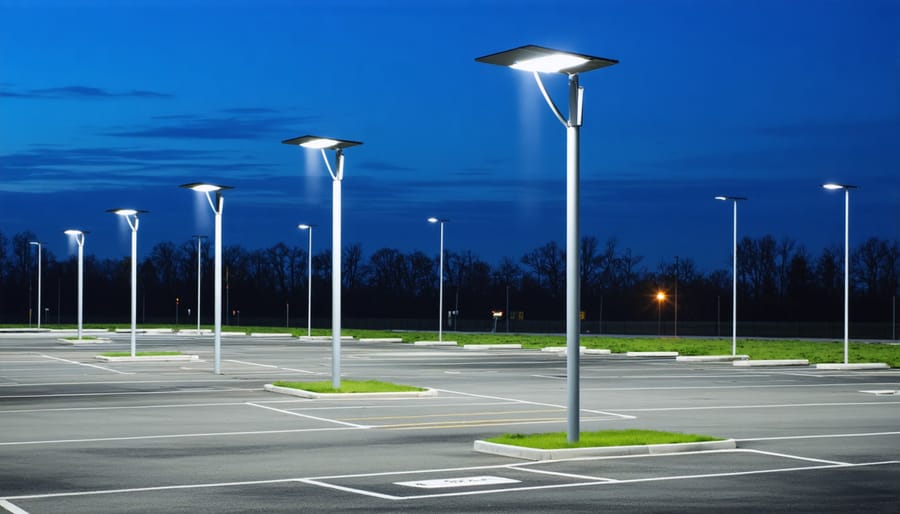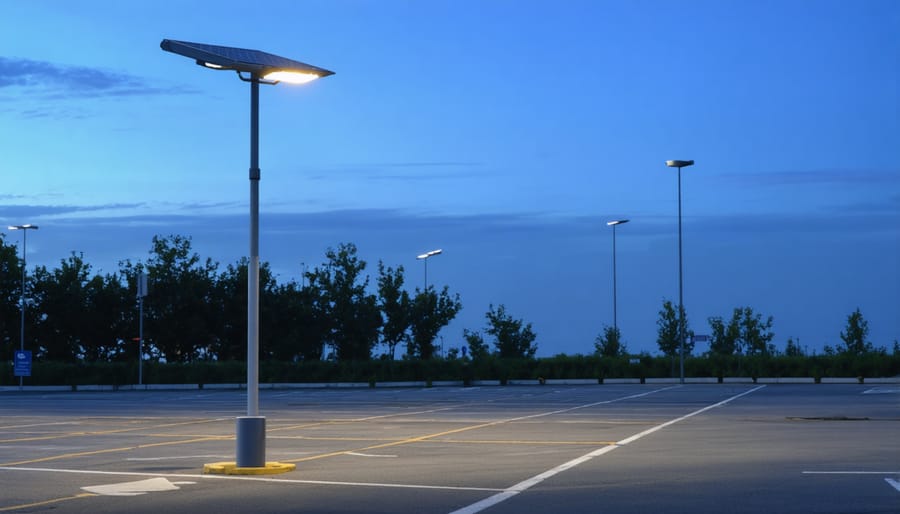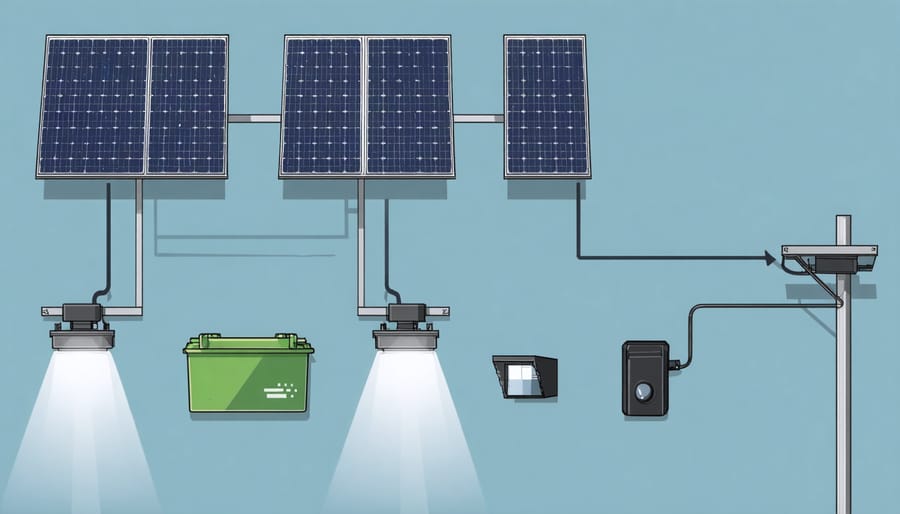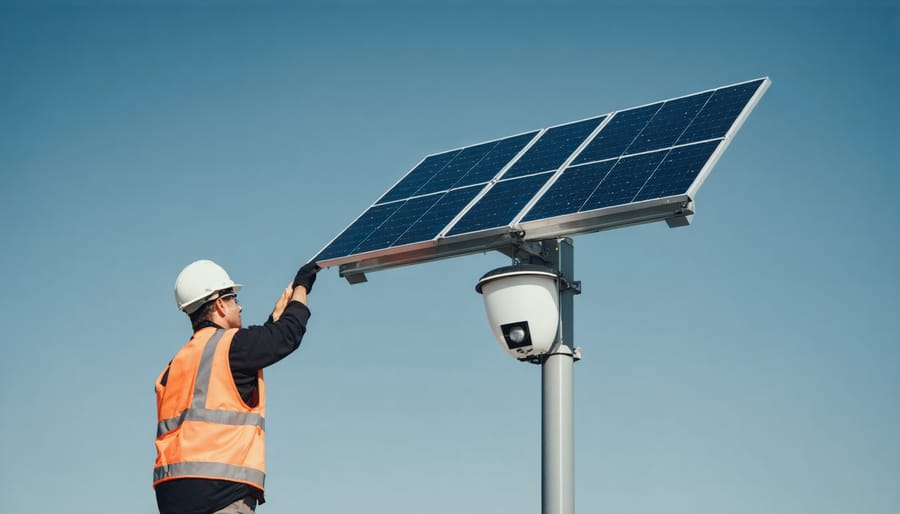Smart Solar Parking Lights That Cut Energy Costs While Boosting Security

Transform your parking facility into an energy-efficient hub with motion-sensor solar lighting, a cornerstone of modern smart energy solutions. These intelligent lighting systems reduce energy consumption by up to 70% while ensuring optimal visibility and security during peak usage hours. By harnessing solar power and integrating advanced motion detection technology, these systems automatically adjust illumination levels based on real-time activity, eliminating unnecessary power consumption during quiet periods.
European facility managers increasingly rely on solar parking lot lights with motion sensors to meet stringent EU sustainability requirements while significantly reducing operational costs. The combination of zero-grid energy consumption, minimal maintenance requirements, and enhanced safety features makes these systems an ideal choice for modern parking infrastructure. With rapid advancement in LED technology and smart controls, these systems now offer unprecedented reliability and performance, even in regions with limited sunlight exposure.
How Motion-Sensor Solar Parking Lights Transform Safety and Efficiency
The Smart Integration of Solar and Motion Detection
Modern solar parking lot lights integrate sophisticated motion detection systems with advanced solar technology for optimal performance. The core components include high-efficiency photovoltaic panels, smart motion sensors, LED luminaires, and an intelligent control unit. During daylight hours, the solar panels harvest energy, storing it in lithium-ion batteries for nighttime operation.
The motion detection system employs passive infrared (PIR) sensors that monitor movement within a defined radius, typically 10-15 meters. When activated, these sensors trigger the lights to increase from a low-power standby mode (usually 20-30% brightness) to full illumination. This smart dimming feature significantly extends battery life while maintaining essential security lighting.
The control unit serves as the system’s brain, managing the interplay between components. It monitors battery levels, adjusts lighting patterns based on stored energy, and fine-tunes sensor sensitivity according to environmental conditions. Many modern systems also include remote monitoring capabilities, allowing facility managers to optimize performance and track energy usage through mobile applications or web interfaces.
This integration ensures reliable, energy-efficient illumination while maximizing the system’s operational lifespan and reducing maintenance requirements.

Key Benefits for Facility Managers
Facility managers implementing industrial solar lighting solutions with motion sensors in parking lots experience multiple substantial advantages. The most immediate benefit is significant energy cost reduction, with savings typically ranging between 40-70% compared to traditional lighting systems. This efficiency stems from the dual advantage of harvesting solar power and smart motion-activated operation.
Maintenance requirements decrease dramatically, as LED components used in solar fixtures last up to 50,000 hours, reducing replacement frequency and associated labour costs. The self-sufficient nature of these systems eliminates the need for complex wiring infrastructure, simplifying both installation and ongoing maintenance procedures.
Security enhancement stands out as another crucial advantage. Motion sensors ensure optimal illumination exactly when needed, deterring unauthorised access while maintaining energy efficiency. The system automatically adjusts brightness levels based on movement detection, providing maximum visibility during activity and reduced output during quiet periods.
The automated operation also contributes to improved safety for facility users. Sensors respond instantly to movement, ensuring pathways and parking areas are well-lit before users enter the space. This proactive illumination helps prevent accidents and creates a more secure environment for staff and visitors.
Additionally, these systems align perfectly with EU sustainability goals and often qualify for regional green energy incentives, offering both environmental and financial benefits for facility operators.
Essential Technical Specifications

Illumination Power and Coverage
Modern solar parking lot lights with motion sensors deliver impressive illumination capabilities, typically ranging from 5,000 to 15,000 lumens per fixture. This output ensures optimal visibility across parking areas while maintaining energy efficiency. A single unit can effectively illuminate 50-80 square metres, with the exact coverage depending on mounting height and light distribution pattern.
These systems automatically adjust their brightness based on motion detection, operating at 30% power in standby mode and increasing to 100% when movement is detected within their 8-12 metre sensing radius. This smart functionality extends battery life while maintaining security standards.
The LED fixtures used in these systems typically offer colour temperatures between 4000K and 5000K, providing clear, natural-white illumination that enhances visibility and safety. Their uniform light distribution eliminates dark spots and ensures consistent coverage throughout the parking area.
For European installations, these systems are designed to meet EN 12464-2 lighting standards for outdoor workplaces, delivering the required minimum illuminance levels of 5-20 lux for parking areas, depending on traffic intensity and security requirements.
Battery Life and Energy Storage
Modern solar parking lot lights are equipped with high-capacity lithium-ion batteries that ensure reliable performance throughout the night and during periods of limited sunlight. These advanced storage systems typically provide 3-5 days of autonomy, meaning they can operate independently even during extended cloudy periods.
The battery capacity varies depending on the model, but most systems offer between 12V/24V configurations with storage capacities ranging from 20Ah to 60Ah. This substantial storage capacity, combined with intelligent power management systems, enables the lights to maintain optimal brightness levels while maximising energy efficiency.
When integrated with motion sensors, these systems become even more energy-efficient. During low-activity periods, the lights operate at 20-30% brightness, automatically increasing to full power when movement is detected. This smart energy management approach extends battery life and ensures sustained performance throughout the system’s 8-10 year operational lifespan.
For European installations, the batteries are designed to perform efficiently in temperatures ranging from -20°C to 60°C, making them suitable for various climate conditions across the continent.
Installation and Maintenance Considerations
Optimal Positioning for Maximum Efficiency
For optimal performance, position solar panels at a 30-45 degree angle, facing south in the Northern Hemisphere. This orientation maximises sun exposure throughout the day and seasons. Mount the panels high enough to avoid shadows from surrounding structures or vegetation, typically 4-6 metres above ground level.
Motion sensors require strategic placement to ensure comprehensive coverage. Install sensors 2.5-3 metres high, with a clear line of sight across the parking area. For most installations, position sensors to create overlapping detection zones, eliminating blind spots. Consider the traffic flow patterns and arrange sensors to activate lights before visitors enter darker areas.
The control box should be easily accessible for maintenance while remaining protected from the elements. In European climates, ensure all components are rated IP65 or higher for weather resistance. Regular cleaning of both panels and sensors maintains optimal efficiency, particularly in areas with high pollution or seasonal pollen.

Long-term Maintenance Requirements
Solar parking lot lights with motion sensors require minimal yet consistent solar lighting maintenance to ensure optimal performance. Annual inspections should focus on cleaning solar panels to remove dust, leaves, and bird droppings that can reduce charging efficiency. Battery health checks are recommended every 18-24 months, with typical replacement needed every 5-7 years. Motion sensors should be tested quarterly and adjusted for sensitivity if necessary.
The LED fixtures typically last 50,000-100,000 hours but should be inspected annually for any signs of damage or decreased brightness. Mounting hardware requires checking every two years to ensure structural integrity. During winter months, snow removal from solar panels is essential to maintain charging capability. Most systems include remote monitoring capabilities, allowing for proactive maintenance scheduling and immediate fault detection. Establishing a regular maintenance schedule helps prevent system failures and extends the installation’s lifespan significantly.
Solar parking lot lights with motion sensors represent a smart, sustainable investment that delivers multiple benefits for European property owners and businesses. By combining advanced solar technology with intelligent motion detection, these lighting solutions offer significant energy savings while ensuring optimal security and visibility when needed. The initial investment is offset by eliminated electricity costs, reduced maintenance requirements, and enhanced property value.
As Europe continues its journey toward sustainability targets, implementing these systems demonstrates environmental leadership while complying with regional lighting regulations. The flexibility of installation, coupled with the reliability of modern solar technology, makes these solutions particularly attractive for both new developments and retrofitting existing parking facilities.
Consider the long-term advantages: zero operational costs, reduced carbon footprint, improved safety for visitors, and contribution to smart city initiatives. With current technological advancements and increasing focus on sustainable infrastructure, there has never been a better time to upgrade your parking facility with solar-powered motion sensor lighting. Take the step toward a more sustainable and efficient future while ensuring your property meets modern safety and environmental standards.
Leave a Reply